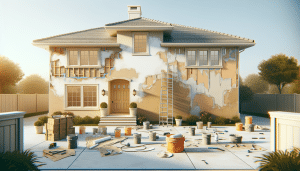Fiber Cement Siding is a favorite among homeowners for its durability and aesthetic appeal. However, improper installation can lead to issues. At Utah Siding & Exteriors, we specialize in making your siding dreams come true. Here’s a comprehensive guide to the do’s and don’ts of fiber cement Siding Installation to ensure your project is a success.
Understanding the Material
Fiber cement siding is a composite material made from cement, sand, and cellulose fibers. This combination results in a product that is both strong and versatile. But remember, proper handling and installation are crucial to its longevity and performance.
One of the main advantages of fiber cement siding is that it can mimic the appearance of wood, stucco, or masonry without the maintenance. However, because it is heavier than other siding materials, you need to follow specific guidelines to avoid any issues down the road.
Do: Choose the Right Tools
Having the right tools can make or break your fiber cement siding installation.
- Proper Saw: Always use a circular saw equipped with a diamond-tipped blade specifically designed for fiber cement. This prevents chipping and ensures clean cuts.
- Protective Gear: Use safety glasses and dust masks. Cutting fiber cement generates a lot of silica dust, which can be harmful when inhaled.
- Level: A good level ensures your siding is straight and even. Inaccuracy can lead to water infiltration and other long-term problems.
- Cordless Drill: A cordless drill with adjustable torque settings helps to prevent over-driving screws and damaging the siding.
- Measuring Tape: Precision is key. Accurate measurements will save you time and materials.
Don’t: Ignore Building Codes
Complying with local building codes is not optional. Doing so not only ensures safety but also avoids potential legal issues.
Check your local building regulations before starting your siding installation. Ignoring these rules can result in hefty fines and might even require you to redo the entire job.
If you’re unsure about what codes apply to your area, consult with a professional. At Utah Siding & Exteriors, we are well-versed in all relevant codes and standards, ensuring your project is compliant from start to finish.
Do: Prepare the Surface
Proper surface preparation is fundamental for a successful installation.
Ensure the sheathing is flat, and all surfaces are clean and dry before you start installing the siding. You can use a house wrap or felt paper as an added layer of protection against moisture.
This step will prevent complications like warping and provides a solid foundation for your new siding. Remember, taking the time to prep now will save you from headaches later on.
Don’t: Overdrive Nails
Nailing fiber cement siding should be done with caution.
Use a pneumatic nailer set to the correct pressure to avoid overdriving the nails. If nails are driven in too far, they can break the siding, compromising its structural integrity.
Nails should be driven flush with the surface, not countersunk. Improper nailing techniques can lead to cracking and water damage over time.
Do: Follow Manufacturer Guidelines
Every brand of fiber cement siding has its own set of instructions and guidelines.
It’s crucial to read and follow the manufacturer’s instructions. These guidelines are set to ensure optimum performance and durability of your siding.
Failing to follow these recommendations can void your warranty and lead to installation issues. At Utah Siding & Exteriors, we always adhere to these guidelines to ensure your satisfaction.
Don’t: Butt Joints Tightly
When joining pieces of fiber cement siding, avoid butting them too tightly.
Fiber cement expands and contracts with changes in temperature. Always leave a small gap—typically around 1/8 inch—between the joints to accommodate this movement.
This gap will prevent potential issues like buckling or cracking, ensuring that your siding remains in excellent condition for years to come.
Do: Use Proper Flashing
Correct flashing is essential to protect against moisture intrusion.
Install flashing around windows, doors, and other openings to direct water away from the structure. This not only improves the lifespan of your siding but also protects the underlying structure from water damage.
Skipping this step can lead to serious problems like mold growth and wood rot. At Utah Siding & Exteriors, we make sure every part of your home is well-protected.
Don’t: Paint Immediately
It might be tempting to start painting your new fiber cement siding right away, but patience is key.
Allow the siding to cure for a few days, as painting too soon can trap moisture inside, leading to peeling and cracking down the line.
Seal the edges of the panels with primer before installation and apply a high-quality exterior paint. This ensures excellent adhesion and long-lasting color.
Do: Regular Maintenance
Once your fiber cement siding is installed, maintenance is key to making sure it stays attractive and functional.
Regularly inspect your siding for any signs of damage or wear. Address minor issues promptly to avoid costly repairs.
Clean your siding annually using a garden hose and a mild detergent. This keeps it looking good and extends its lifespan.
Contact Us Today!
For professional fiber cement siding installation, trust the experts at Utah Siding & Exteriors. Contact us by phone # 801-509-9241 or Request a Free Quote.




